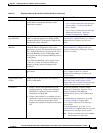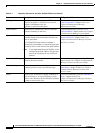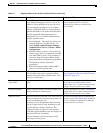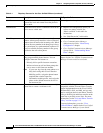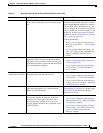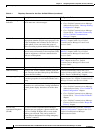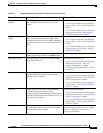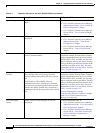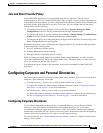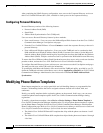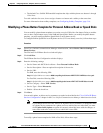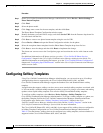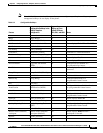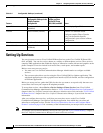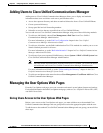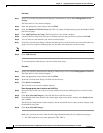
5-13
Cisco Unified IP Phone 6921, 6941, and 6961 Administration Guide for Cisco Unified Communications Manager 7.1 (SCCP)
OL-19025-01
Chapter 5 Configuring Features, Templates, Services, and Users
Configuring Corporate and Personal Directories
Join and Direct Transfer Policy
Some JTAPI/TAPI applications are not compatible with the Join and Direct Transfer feature
implementation on the Cisco Unified IP Phone 6921, 6941, and 6961. In order for these applications to
control and monitor these phones, you must configure the Join and Direct Transfer Policy to disable join
and direct transfer on the same line or possibly across lines. You can configure the Join and Direct
Transfer Policy for the following:
• To configure the policy for all phones on the system, choose System > Enterprise Phone
Configurations from Cisco
Unified Communications Manager Administration.
• To configure the policy to a group of phones, choose Device > Device Settings > Common Phone
Profile from Cisco
Unified Communications Manager Administration.
• To configure the policy on an individual phone, configure the Join and Direct Transfer Policy in the
Phone Configuration for the specific phone.
Because this parameter can be configured in three different windows, the setting that takes precedence
is determined in the following order:
1. Device Configuration window settings
2. Common Phone Profile window settings
3. Enterprise Phone Configuration window settings.
When you change the setting of the Join and Direct Transfer Policy Parameter, you must check the
“Override Common Settings” box for the setting to take effect. The default policy is to have Same line,
across line enabled for join and direct transfer.
To determine the proper setting for this parameter, refer to the documentation of the JTAPI/TAPI
application.
Configuring Corporate and Personal Directories
The Contact button on the Cisco Unified IP Phone 6921, 6941, and 6961 gives users access to several
directories. These directories can include:
• Corporate Directory—Allows a user to look up phone numbers for co-workers.
To support this feature, you must configure corporate directories. See the “Configuring Corporate
Directories” section on page 5-13 for more information.
• Personal Directory—Allows a user to store a set of personal numbers.
To support this feature, you must provide the user with software to configure the personal directory.
See the
“Configuring Personal Directory” section on page 5-14 for more information.
Configuring Corporate Directories
Cisco Unified Communications Manager uses a Lightweight Directory Access Protocol (LDAP)
directory to store authentication and authorization information about users of Cisco
Unified
Communications Manager applications that interface with Cisco
Unified Communications Manager.
Authentication establishes the users’ rights to access the system. Authorization identifies the telephony
resources that a user is permitted to use, such as a specific phone extension.
For more information, go to “Understanding Directory Numbers” in the Cisco Unified Communications
Manager System Guide.



